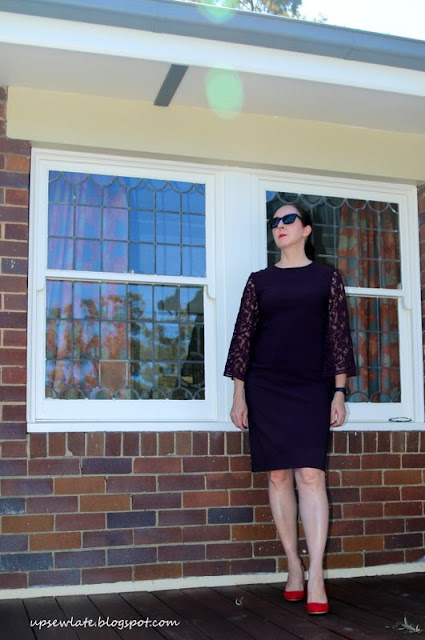This particular Esme cardigan, made in a heavy double knit (and mostly polyester, I believe) is ridiculously cosy. It's as cosy as some of my coats, but it's also snuggly enough to stay on when I'm lounging around the house or sitting at a desk and working on the computer (unlike my coats). It's pretty much like wearing a blanket!
I absolutely love it.
Pattern: Esme cardigan by Named Patterns
Fabric: double knit (by which I mean double-layered knit) bought at a crazy sale at Spotlight for next to nothing
Overall: an easy and satisfying sew, slowed down by my need to:
- match the direction of the houndstooth (yes, it's a directional print) and align the horizontals in cutting out
- align the horizontals in sewing the main seams
- align the direction and horizontals between the button band and the cardigan fronts
- align the print in the pocket openings
I think you can see the pattern alignment / matching between the bands and the cardigan fronts in this flat photo:
And in this next photo you might JUST be able to see that the houndstooth pattern runs down the cardigan fronts right over the pockets without getting out of line :). It doesn't look like my pattern matching on that side seam worked perfectly though:
I made a few changes to the cardigan as I went:
- omitted the interfacing on the band - a conscious decision, because I wanted the band to have the same amount of stretch as the main part of the cardigan, and I knew the fabric was heavy enough that it probably didn't need interfacing. I've seen a few Esme cardigans where the interfaced button band has stretched less than the cardigan body - I'm not sure how you'd avoid this is you interfaced the band, but I'm also not sure why you need the interfacing there when you're not adding closures.
- omitted interfacing on the pocket openings - not needed with a cut-on pocket.
- cut the pocket bags as part of the cardigan front (one pair of upper cardigan fronts with cut-on pocket bags, and one pair of lower cardigan fronts with cut-on pocket bags).
The pocket bags are recommended to be sewn from a lighter knit, but if you don't mind them being made from the same fabric as the outer cardigan, a cut-on pocket is sleeker. And because the pockets are quite slouchy (more slouchy than they would have been with interfacing, but I suspect they were always going to be somewhat slouchy) the pocket bags are exposed, so a difference in fabrics would have drawn the eye.
Here are a couple more pocket photos - and yes, those pockets were flapping around too much! Right after taking these pictures I tacked the bottom corners of the pockets to the inner layer of my cardigan fronts, and they now don't show.
Notes:
- as drafted this cardigan is super long, and will grow longer in a heavy fabric. I cut some of the length off, and still have a deep hem. It's definitely drafted for tall women so I'd recommend checking how much of that length you want before cutting out (or buying) your fabric.
- the sleeves are pretty narrow, and significantly narrower than I expected. Next time around I might make them wider to allow for more layering options - as they are I can only fit a thin merino or cotton layer underneath
Although I love this cardigan and wore it pretty much constantly for a few months after wearing it, I'm not sure if it reads "dressing gown"! What do you think? Does a dressing gown have to have a cord to tie around the waist? I keep thinking of those old fashioned checked flannel gowns!
I haven't shown you the back view yet, have I - from behind it's a very plain and boxy shape:
It took a while for this pattern to grab me - it looked quite boxy in the line drawings (and it is boxy), and I thought I was hankering after a cardigan with a bit more shaping. But as winter progressed I noticed people around me wearing cosy-looking, long boxy cardigans just like Esme, and I realized this sort of cardigan was versatile and practical (and sometimes even stylish).
I'm not convinced mine's particularly stylish, but with its muted grey/cream colours I've been able to pair it reasonably well with a black dress or trousers in the office, and even better with jeans and a merino top or t-shirt at home. No one's pulled me aside and told me to get dressed, though when I've asked a few family members they have agreed it's quite dressing gown-like.
Hmm... maybe it can be both a cardigan and a gown, depending on what you wear underneath?
- Gabrielle xx






























